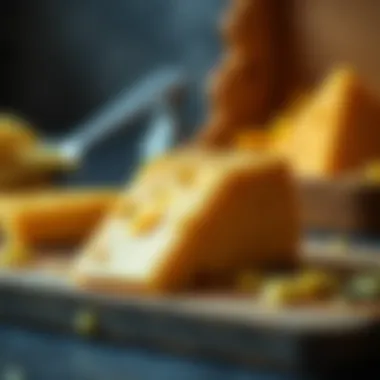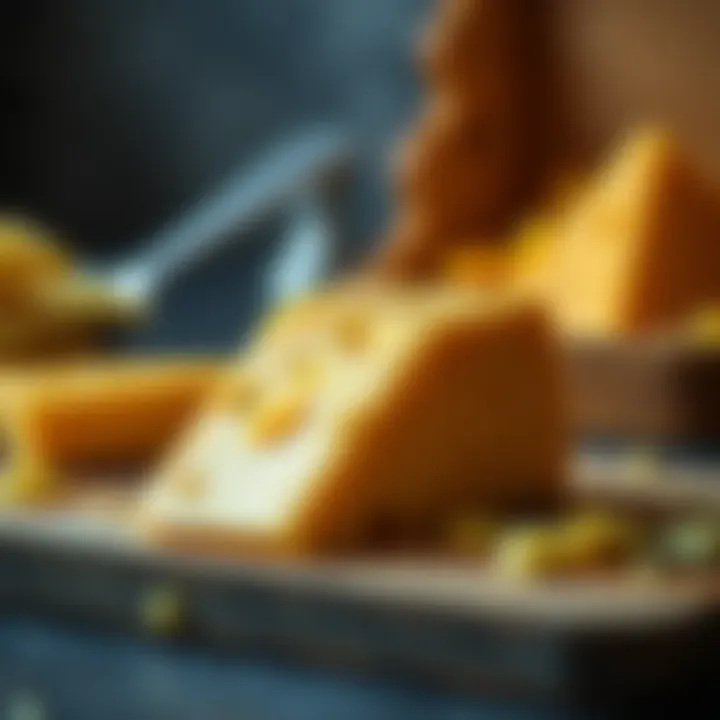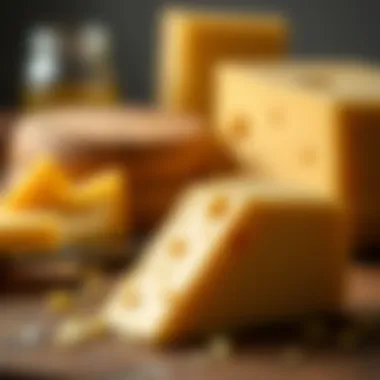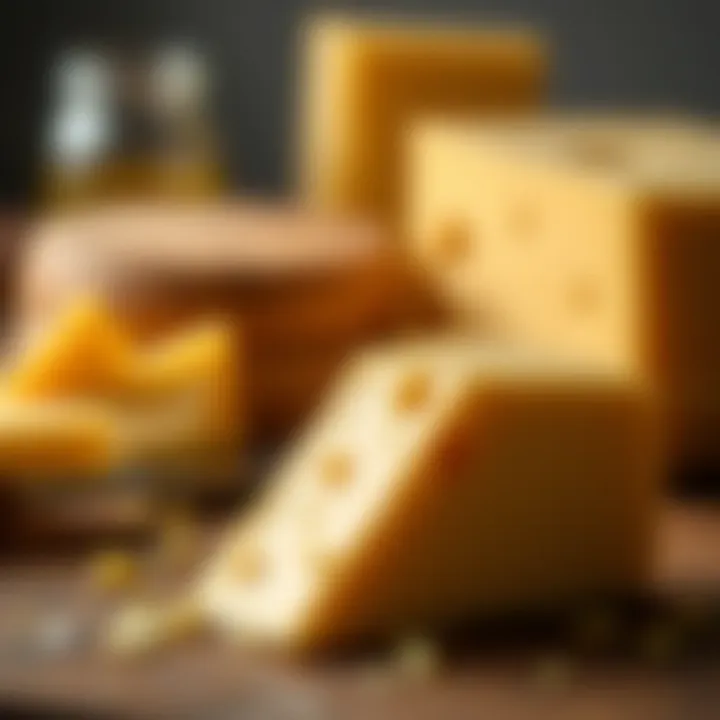Nutritional Insights on Sharp Cheddar Cheese


Intro
When we talk about cheese, sharp cheddar holds a special spot on the palate of many food enthusiasts. Beyond its distinct flavor, which can make or break a dish, lies a rich tapestry of nutrients that cater to various dietary needs. This article takes a closer look at sharp cheddar cheese's nutritional profile, its impact on health, and how it fits into modern diets.
Arguably, it's not just a tasty addition to a cheeseboard, but a treasure trove of nutrition. As we slice through its nutritional content, we’ll explore how it can benefit different age groups and lifestyles while considering some health implications. Remember, moderation is key when it comes to dietary choices involving rich foods like cheese.
Ingredients Breakdown
Primary Ingredients
Sharp cheddar cheese isn't just made from basic components. Its main ingredient is milk—specifically cow's milk, which can vary depending on the cheese's origin. The process generally involves:
- Milk: The star of the show.
- Rennet: Enzyme used to curdle the milk.
- Starter Cultures: Bacteria which contribute to flavor and texture development.
- Salt: Enhances flavor and acts as a preservative.
The magic happens during the aging process. This gives sharp cheddar its distinctive taste and crumbly texture, setting it apart from other cheeses.
Optional Ingredients
While traditional sharp cheddar is delightful on its own, some varieties mix in optional ingredients for flair. These can include:
- Herbs and Spices: Like garlic or chili flakes, to give it a unique twist.
- Nuts: Pecans or walnuts can offer a nice crunch when incorporated.
- Smoked Variants: Infusing smoke flavor adds complexity.
Essential Kitchen Tools
Cooking with sharp cheddar can be simple, but having the right tools makes a difference:
- Grater or Food Processor: Perfect for shredding or grating cheese.
- Cheese Knife: Useful for precise cuts, especially in charcuterie boards.
- Mixing Bowls and Cooking Pots: For recipes that require melting or mixing.
Nutritional Profile
Understanding the nutrition behind sharp cheddar cheese sheds light on its benefits and potential drawbacks:
- Calories: Around 115 per ounce, which isn't insignificant.
- Protein: Roughly 7 grams.
- Fat: 9 grams, including 6 grams of saturated fatty acids.
- Calcium: A good source, providing about 20% of the daily recommended intake.
While the fat content might raise eyebrows, it’s essential to balance this with the protein and calcium benefits it brings.
"Moderation and balance are the best ingredients for healthy eating."
Dietary Considerations
Gluten-Free Options
For those monitoring their gluten intake, good news—sharp cheddar cheese is naturally gluten-free. This means, whether you’re looking for a snack or adding it to a dish, it can fit into a gluten-restricted diet without worry.
Vegetarian and Vegan Substitutes
While traditional sharp cheddar isn't vegan due to milk content, there are plant-based options emerging in the market. These are often made from nuts, soy, or tapioca. Always check labels to ensure they meet your dietary preferences.
Nutrition Facts & Nutritional Considerations
When considering sharp cheddar as a part of your diet, it's crucial to keep in mind that despite its benefits, it's also rich in calories and fat. Thus, consumption should align with your overall dietary plan, especially if you're watching your weight or cholesterol levels.
Common Common Questionss and Troubleshooting
Frequently Asked Questions
- Is sharp cheddar cheese healthy?
Yes, if consumed in moderation, as it contains beneficial protein and calcium but is high in saturated fat. - Can cheese go bad?
Yes, improper storage can lead to spoilage, so keep it wrapped well in the fridge.
Common Mistakes to Avoid
- Overindulgence can lead to calorie overload.
- Not shredding before mixing can lead to uneven melting in recipes.
Solutions to Potential Problems
If the cheese is hard or dry, try warming it slightly before using, or incorporate it into cooked dishes to enhance texture.
In summary, sharp cheddar cheese is more than just a simple ingredient; it's a combination of history, flavor, and nutrition that can enrich our meals and our lives. Understanding its components, how to best incorporate it into a diet, and knowing the potential health impacts is critical for making informed choices.
For more details on the nutritional impacts of cheese, you can refer to resources like Wikipedia or Britannica.
Explore and enjoy your cheesemaking journey!


Prelude to Sharp Cheddar Cheese
Sharp cheddar cheese, distinguished by its robust flavor and distinctive texture, holds a significant place in culinary practices across the globe. This article explores its nutritional richness while emphasizing its prominent role in balanced diets. Understanding sharp cheddar not only caters to our taste buds but also allows us to navigate its nutritional benefits and considerations thoughtfully.
Defining Sharp Cheddar Cheese
Sharp cheddar cheese is a variety that forms from cow's milk, made through a well-defined cheesemaking process. The aging process, usually lasting a minimum of five months, develops its unique sharpness, offering flavors that range from mildly tangy to piquant. It is characterized by its crumbly texture and vibrant yellow-orange hue, often attributed to the addition of annatto—a natural coloring agent. Besides its intriguing flavor profile, sharp cheddar is often lauded for its versatility in cooking, lending richness to dishes or standing out as a centerpiece on cheese boards.
The distinction between sharp cheddar and its milder counterparts largely relies on both the aging process and the unique bacteria utilized during its fermentation. This specific approach results in a complex flavor that can include various nutty, fruity, or even earthy notes, making a distinctive mark in various cuisines.
Culinary Uses of Sharp Cheddar
The culinary applications of sharp cheddar cheese span from traditional to innovative, appealing to palates of all ages. Some popular uses include:
- Macaroni and Cheese: A classic comfort food, sharp cheddar adds a rich depth.
- Cheese Boards: Its bold flavor makes sharp cheddar a sought-after selection.
- Toppings and Dishes: Whether melted atop burgers or grated over salads, it enhances a variety of meals.
- Baking: Incorporating sharp cheddar into scones or breads introduces an unexpected but delightful twist.
As we consider sharp cheddar in our diets, it's essential to grasp that its flavor intensity enhances dishes while providing a good source of calcium and protein. The balance it strikes between taste and nutrition makes it a flavorful choice for anyone seeking comprehensive culinary experiences.
In summary, sharp cheddar cheese stands as a multifaceted ingredient in both everyday meals and gourmet cuisine, recognized for its flavor and nutritional advantages.
Nutritional Overview
Understanding the nutritional profile of sharp cheddar cheese is paramount for anyone seeking to make informed dietary choices. This section sheds light on the composition of this popular cheese, elaborating on the essential macronutrients and micronutrients it contains. The significance of this overview lies not just in numbers and percentages; it highlights how each component plays a role in maintaining good health and contributing to overall wellbeing.
Macronutrient Breakdown
Protein Content
Protein is an essential macronutrient found abundantly in sharp cheddar cheese. One ounce typically contains about 7 grams of protein, which is significant when considering dietary needs. For folks looking to bolster their intake—whether for muscle repair or general health—sharp cheddar is a great option. This cheese is particularly appealing because it provides complete proteins, meaning it contains all nine essential amino acids.
The unique quality of the protein in cheddar lies in its digestibility. Unlike some plant-based protein sources that might leave individuals feeling heavy, the protein found in cheese can be easily absorbed. For those engaged in physical activity or seeking to maintain muscle mass, incorporating sharp cheddar can offer both satisfaction and nutrition.
Fat Composition
The fat content in sharp cheddar cheese plays a dual role. On one hand, it’s about 9 grams of fat per ounce, contributing to the richness and creamy texture that many love. On the other, the type of fat present is noteworthy. Most of the fat is saturated fat, which has been a topic of significant debate in dietary discussions.
Yet, this cheese employs some healthy fat that can be beneficial in moderation. This includes conjugated linoleic acid (CLA), which has been linked to weight management and improved metabolic profiles. Understanding the balance of fats—along with the complete dietary context—can help consumers navigate their choices more wisely.
Carbohydrate Levels
When one thinks of cheese, carbohydrates usually don’t come to mind. For sharp cheddar, this is also true. Typically, it bears a very low carbohydrate content, around 1 gram per ounce. This quality makes it an exceptionally favorable choice for those on low-carb diets or ketogenic lifestyles.
The drawback, however, is that low carbohydrate foods often lack fiber, which is vital for digestive health. Thus, while sharp cheddar serves as an ideal high-protein, low-carb snack, it should ideally be consumed alongside fiber-rich foods to ensure a balanced dietary intake.
Micronutrient Profile
Vitamins in Sharp Cheddar
Sharp cheddar is not just a flavorful treat; it's also a source of vital vitamins. For example, it is rich in vitamin A, necessary for maintaining healthy vision and skin. Additionally, it provides a decent amount of vitamin B12, crucial for energy production and optimizing cellular processes.
What sets these vitamins apart is their ability to contribute to everyday health. While cheese isn't the only source, its inclusion in the diet makes it an easy way to ensure these nutrients are being consumed.
Minerals Present
Minerals, particularly calcium, are abundant in sharp cheddar cheese—offering roughly 200 mg per ounce, which is about 20% of the recommended daily intake. Calcium is essential not only for bone health but also for the physiological functions like muscle contractions and nerve signaling.
Moreover, sharp cheddar contains phosphorus, which works hand-in-hand with calcium, supporting optimal bone formation and maintaining energy levels. This synergy of minerals provides cheddar enthusiasts yet another reason to appreciate this cheese.
"Incorporating sharp cheddar cheese into your diet can be a tasty endeavor that doesn't just satisfy your cravings but also elevates your nutritional profile."
Caloric Content Analysis
Understanding the caloric content of sharp cheddar cheese is essential for anyone looking to maintain a balanced diet. Caloric content refers to the amount of energy that food provides when consumed. This energy is crucial for bodily functions and helps fuel daily activities. In this section, we'll dissect both the calorie composition and the factors influencing its energy density, empowering readers to make informed dietary choices.
Understanding Caloric Composition
The caloric composition of sharp cheddar cheese can vary based on several factors, including the specific brand and manufacturer. However, when we talk about average caloric values, one ounce of sharp cheddar typically contains around 110 calories. This number is significant, particularly when considering its role in meal planning.
Here are some key points to note regarding caloric composition:


- Calories from Fat: A large portion of the calories in sharp cheddar come from fat. In general, fat tends to be more calorie-dense than carbohydrates and proteins.
- Role of Protein: Cheddar cheese is not just about fat; it also provides a decent source of protein, contributing to its overall caloric content.
- Influence of Serving Size: Depending on how much of it one consumes, the total caloric intake can change, making it vital to be aware of portion sizes.
The way sharp cheddar cheese fits into an individual’s overall caloric intake is important for maintaining energy levels. If someone has a goal, be it weight loss or muscle gain, then these numbers can play into daily caloric requirements significantly.
Energy Density Factors
Energy density is a measure of how many calories a food has relative to its weight or volume. High-energy-dense foods provide a lot of calories in a small amount of food, which is true for sharp cheddar cheese. Here are some factors to consider:
- Fat Content: The high fat content in sharp cheddar cheese adds to its energy density. Fat provides about nine calories per gram, compared to four calories per gram for protein and carbohydrates.
- Moisture Levels: The moisture content can also impact energy density. Sharp cheddar tends to be relatively low in moisture, making it richer in calories per ounce compared to moisture-rich cheeses.
- Processing: The manufacturing process of cheese can affect its fat and protein proportions, thus altering its caloric density slightly.
"For those mindful of calorie intake, understanding energy density can make all the difference in meal planning."
In summary, sharp cheddar cheese is fairly energy-dense due to its high fat content and lower moisture levels. Balancing this along with other food choices can lead to a well-rounded diet. Knowing how sharp cheddar fits into your daily caloric goals aids in making smart dietary choices.
Health Implications of Consuming Sharp Cheddar
Understanding the health implications of consuming sharp cheddar cheese is paramount for anyone keen on making well-informed dietary choices. This section delves into the multifaceted benefits and possible drawbacks of incorporating sharp cheddar into one’s diet, offering a nuanced perspective that balances nutritional advantages with cautionary advice. By evaluating both sides, readers can better understand how to include this popular cheese variety in their meals while maximizing its benefits and minimizing potential health risks.
Benefits of Sharp Cheddar Cheese
Nutritional Benefits
Sharp cheddar cheese packs a nutrient-dense punch that can enrich your daily intake. This cheese is particularly well-known for its high protein content, with a single ounce delivering around 7 grams of protein. Protein is crucial for muscle repair and growth, making sharp cheddar a favorable option for physically active adults.
- The richness in calcium makes sharp cheddar a standout. Calcium is essential for strong teeth and bones, thereby reducing the risk of osteoporosis as one ages.
- Moreover, it contains vitamins like A and B12, which are vital for vision and neurological function, respectively.
With such a robust profile, sharp cheddar cheese offers a culinary twist to those looking to amplify their nutritional intake without compromising flavor. Choosing sharp cheddar can be a beneficial choice for those in pursuit of hearty and nutritious snacks or meal enhancements.
Potential Role in Bone Health
The potential role of sharp cheddar cheese in supporting bone health is worth noting. Given its high calcium and phosphorus content, sharp cheddar can contribute significantly to maintaining bone density. Calcium is often touted as the building block of bones, and the presence of phosphorus plays a critical role in calcium absorption and utilization within the body.
- Regular consumption of sharp cheddar can be beneficial for post-menopausal women, who are at a higher risk for bone density loss.
- Also, children and adolescents can benefit from the calcium boost, supporting their growth and development stages.
This unique feature makes sharp cheddar an appealing addition to diets aimed at bolstering bone health, thus providing an easy, palate-pleasing way to consume these essential nutrients.
Concerns with Excess Consumption
While sharp cheddar has its advantages, moderation should be the name of the game. Overindulgence in this flavorful cheese could bring about certain health concerns that merit attention.
High Sodium Levels
A pivotal consideration when consuming sharp cheddar cheese relates to its sodium content. With about 174 milligrams of sodium per ounce, sharp cheddar can contribute significantly to the daily recommended sodium intake if consumed excessively.
- High sodium intake poses the risk of high blood pressure and can be detrimental to heart health over time.
- For individuals sensitive to sodium or those who have hypertension, moderation becomes even more crucial.
Understanding this aspect of sharp cheddar helps in making wiser choices, especially for those monitoring their sodium levels.
Saturated Fat Considerations
Another area to ponder when including sharp cheddar cheese in diets is its saturated fat content. An ounce of this cheese contains around 6 grams of saturated fat, which can be a concern for heart health.
- Saturated fats, when consumed in excess, can raise levels of LDL cholesterol in the blood, increasing the risk of cardiovascular diseases.
- However, it’s important to note that not all saturated fats are created equal. Some studies suggest moderate consumption might not have the dire effects previously assumed.
In light of this, maintaining balance is key. Managing how much sharp cheddar one consumes while ensuring a varied diet can position consumers to reap the benefits without falling victim to the downsides.
In summary, enjoying sharp cheddar cheese in moderation may yield health benefits while also requiring careful consideration of its sodium and saturated fat content.
Ultimately, sharp cheddar can be a delightful and nutritious addition to a balanced diet, provided that individuals remain conscious of their intake and overall nutritional landscape.
Dietary Considerations
Understanding how sharp cheddar cheese fits into various dietary frameworks is essential for anyone looking to make informed nutritional choices. It's not just about taste; the dietary approach one takes can significantly influence health outcomes. Sharp cheddar, due to its rich flavor and unique nutrient profile, can be a versatile addition to many diets, but consideration of individual dietary needs is paramount.
Incorporating Sharp Cheddar into Various Diets
Balanced Diets
A balanced diet is all about harmony. It includes the right proportions of carbohydrates, fats, proteins, vitamins, and minerals necessary to support overall health. Sharp cheddar can play a role in this diet, as its protein and calcium content contribute to daily nutritional requirements.


The key characteristic of balanced diets is variety. People enjoy flexibility when crafting meals, and sharp cheddar fits right in. When added to salads or whole grain dishes, it enhances flavor without overwhelming other components. However, it's important to keep serving sizes in mind. A unique aspect of balanced diets is the emphasis on moderation, which can help avoid excessive intake of saturated fats often associated with cheese.
Advantages:
- Nutrient-rich, providing protein and calcium.
- Adds depth to meals, encouraging the consumption of vegetables and whole grains.
- Satisfies culinary cravings, making healthy eating enjoyable.
Keto and Low-Carb Lifestyles
The ketogenic (keto) diet has gained traction for its approach to reducing carbohydrate intake while increasing fat consumption for energy. Sharp cheddar is a cheese that is naturally low in carbs, making it a favorable addition to this lifestyle and appealing to those looking to shed pounds.
A key characteristic of the keto diet is its focus on high-fat foods. Sharp cheddar fits neatly into this category, providing a flavor kick that complements many keto-friendly dishes. This type of diet enables individuals to experience the creamy, indulgent taste of cheese without derailing their carbohydrate quota.
Unique features of the keto diet include:
- Higher reliance on fats can promote weight loss through ketosis.
- Sharp cheddar serves as a satisfying snack or ingredient, aiding in meal planning.
Advantages:
- Provides essential nutrients without carbs.
- Helps maintain energy levels and curb hunger.
- Its diverse flavor pairs well with vegetables, meats, and fats.
Allergies and Intolerances
When introducing sharp cheddar into diets, it’s also critical to consider potential allergies and intolerances, primarily lactose intolerance, which affects a significant portion of the global population.
Lactose Intolerance
People with lactose intolerance may experience discomfort when consuming dairy products. This condition stems from the inability to fully digest lactose, the sugar found in milk. For them, sharp cheddar may not always be a suitable choice unless it’s aged properly, as aged cheeses lose some lactose content during the fermentation process.
The key characteristic of lactose intolerance is that it prompts individuals to seek alternative sources of calcium and protein without causing digestive issues. Therefore, knowing about the lactose content in sharp cheddar can be paramount for those affected.
Advantages and considerations include:
- Aging process reduces lactose levels, making it more tolerable for some.
- Allows those with mild sensitivity to enjoy cheese in moderation, yet caution is advised.
Cheese Alternatives
For individuals who cannot tolerate dairy, cheese alternatives have gained popularity. These products, often made from nuts, soy, or other plant-based materials, offer similar culinary experiences without dairy's drawbacks. Unlike sharp cheddar, these alternatives might lack certain nutrients, like calcium or protein, but they present options for flavor and versatility.
Cheese alternatives represent a key shift towards inclusive dietary practices, opening doors for those with allergies or dietary restrictions. Their unique features allow for diverse dishes, enabling all individuals to enjoy flavorsome meals together.
Advantages and considerations include:
- Variety of flavors mimicking traditional cheeses.
- Availability in many supermarkets, convenient for consumers.
- Nutritional variations; may need supplementation for calcium or protein depending on the product.
Sharp Cheddar as Part of a Healthy Lifestyle
In today's fast-paced world, where health trends frequently change and diets come and go, sharp cheddar cheese stands out as a staple that has maintained its popularity across various culinary landscapes. Its distinctive flavor and robust character make it an appealing choice for many, yet it also carries significant nutritional properties that can contribute positively to a balanced lifestyle.
When we consider sharp cheddar cheese in the context of health, it’s essential to highlight some of its benefits. For instance, sharp cheddar is rich in high-quality protein, which aids in muscle repair and growth while helping sustain energy throughout the day. A single ounce can pack a punch of about 7 grams of protein, making it a valuable addition to a post-workout snack or a busy lunch. Additionally, sharp cheddar presents a favorable source of calcium that plays a vital role in maintaining strong bones and teeth. This is especially important as we age, as bone density tends to decline.
However, as with any food, moderation is key, particularly with sharp cheddar, which contains saturated fats and sodium. This brings us to a crucial aspect of incorporating it into our diets: one should always keep an eye on their portion sizes and overall dietary intake. The richness of sharp cheddar enhances its culinary versatility, allowing it to flourish in a variety of dishes without needing to overindulge.
Moderation is Key
Embracing sharp cheddar should come with a solid understanding of moderation. While indulging in this cheese can indeed be a delightful experience, being aware of daily recommended allowances is pivotal. An ounce here and an ounce there can quickly add up, especially for individuals watching their sodium or cholesterol intake.
While a slice of sharp cheddar on a sandwich or grated over a salad can elevate your meal’s flavor, keep track of the total daily contribution it makes to your nutritional goals. For example:
- Daily Protein Needs: Depending on your age, size, and activity level, your protein needs may vary. Sharp cheddar can contribute positively but should complement other protein sources such as legumes, poultry, or fish.
- Calcium Intake: Knowing that one ounce of sharp cheddar provides approximately 20% of the recommended daily value for calcium can help you monitor your intake, especially if you have alternative sources included in your diet.
- Sodium Awareness: With about 174 mg of sodium per ounce, it's wise to limit sharp cheddar if you are predisposed to high blood pressure or heart issues.
Ultimately, finding a sweet spot where you enjoy sharp cheddar without overdoing it leads to more sustainable health practices.
Balance with Other Nutritional Sources
Incorporating sharp cheddar isn’t just about keeping it in moderation; it’s also about finding balance with other nutritional sources. This cheese can complement various food groups and can enhance meals that might otherwise lack flavor or protein content.
Here are some thoughtful ways to balance your diet with sharp cheddar:
- Pairing with Fruits and Vegetables: Think apple slices with sharp cheddar or a sprinkle of shredded cheese over steamed broccoli. Not only does this combine beneficial nutrients, but the contrast in flavors offers a satisfying eating experience.
- Integration into Dishes: Incorporate sharp cheddar into omelets, casseroles, or grain-based bowls. Doing so allows you to enjoy its flavor while benefiting from other food sources like vegetables and whole grains.
- Healthy Snacks: Instead of opting for processed snacks, consider a small serving of sharp cheddar alongside whole-grain crackers or a handful of nuts. This approach keeps the snack nutritious and fulfilling.
suggestion Nutrient Balance Tips:
- Track your daily intake.
- Opt for variety in protein sources.
- Read food labels for sodium content.







